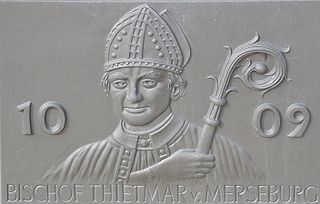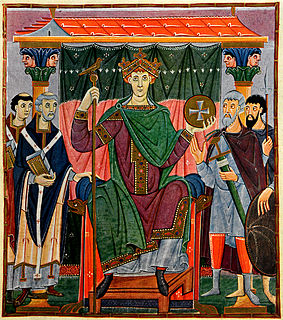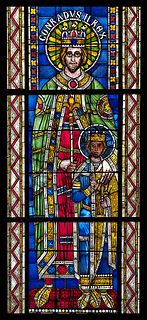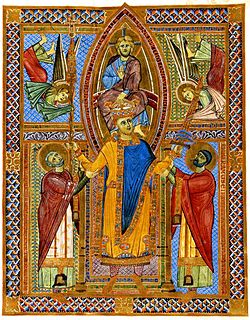Tagino (died 9 June 1012) [1] was the third Archbishop of Magdeburg from 1004 until his death.
Tagino was a chaplain of Henry II, Duke of Bavaria, when, in 995, the See of Regensburg became vacant. He was the duke's candidate for bishop, as well as the candidate of late bishop Saint Wolfgang, and he was elected by the congregation; but the Emperor Otto III appointed his own chaplain Gebhard and instead adopted Tagino into his own royal chaplaincy. [2] Some strife ensued between the duke and the emperor concerning this event.

Henry II, called the Wrangler or the Quarrelsome, a member of the German royal Ottonian dynasty, was Duke of Bavaria from 955 to 976 and again from 985 to 995, as well as Duke of Carinthia from 989 to 995.
When Archbishop Gisilher died in 1004, the cathedral chapter elected as his replacement Walthard, but Henry II of Germany — the son of the old duke of Bavaria — overruled them and appointed Tagino, replacing him as his chaplain with Walthard. [3] As archbishop, Tagino lobbied hard for his own candidates in the suffragan sees of Magdeburg. He and his suffragans were relied upon heavily for military service in the eastern marches. [1] He also worked closely with Bernard I, Duke of Saxony, to (successfully) reconcile Henry of Schweinfurt with the Emperor. [4]

Bernard I was the Duke of Saxony between 973 and 1011, the second of the Billung dynasty, a son of Duke Herman and Oda. He extended his father's power considerably.
Henry of Schweinfurt was the Margrave of the Nordgau from 994 until 1004. He was called the "glory of eastern Franconia" by his own cousin, the chronicler Thietmar of Merseburg.
Tagino remained close to Henry as archbishop. With famous Thietmar of Merseburg in his train, he accompanied Queen Cunigunda from Augsburg to Gernrode and thence Magdeburg in 1004 after Henry had left for his Italian campaign against Arduin. [5] Tagino died in 1012 and was replaced by Walthard.

Thietmar, Prince-Bishop of Merseburg from 1009 until his death, was an important chronicler recording the reigns of German kings and Holy Roman Emperors of the Ottonian (Saxon) dynasty. Two of Thietmar's great-grandfathers, both referred to Liuthar, were the Saxon nobles Lothar II, Count of Stade, and Lothar I, Count of Walbeck. They were both killed fighting the Slavs at the Battle of Lenzen.
Saint Cunigunde of Luxembourg, OSB, also called Cunegundes, Cunegunda, and Cunegonda and, in Latin, Cunegundis or Kinigundis, was Empress of the Holy Roman Empire by marriage to Holy Roman Emperor Saint Henry II. She served as interim Regent after the death of her spouse in 1024. She is a Roman Catholic saint and the Patroness of Luxembourg and Lithuania; her feast day is 3 March.

Augsburg is a city in Swabia, Bavaria, Germany. It is a university town and regional seat of the Regierungsbezirk Schwaben. Augsburg is an urban district and home to the institutions of the Landkreis Augsburg. It is the third-largest city in Bavaria with a population of 300,000 inhabitants, with 885,000 in its metropolitan area.
This page is based on this
Wikipedia article Text is available under the
CC BY-SA 4.0 license; additional terms may apply.
Images, videos and audio are available under their respective licenses.

The Ottonian dynasty was a Saxon dynasty of German monarchs (919–1024), named after three of its kings and Holy Roman Emperors named Otto, especially its first Emperor Otto I. It is also known as the Saxon dynasty after the family's origin in the German stem duchy of Saxony. The family itself is also sometimes known as the Liudolfings (Liudolfinger), after its earliest known member Count Liudolf and one of its primary leading-names. The Ottonian rulers were successors of the Germanic king Conrad I who was the only Germanic king to rule in East Francia after the Carolingian dynasty and before this dynasty.

Year in topic Year 1012 (MXII) was a leap year starting on Tuesday of the Julian calendar.

Otto III was Holy Roman Emperor from 996 until his early death in 1002. A member of the Ottonian dynasty, Otto III was the only son of the Emperor Otto II and his wife Theophanu.

Otto II, called the Red (Rufus), was Holy Roman Emperor from 973 until his death in 983. A member of the Ottonian dynasty, Otto II was the youngest and sole surviving son of Otto the Great and Adelaide of Italy.

Conrad II, also known as Conrad the Elder and Conrad the Salic, was Emperor of the Holy Roman Empire from 1027 until his death in 1039. The founder of the Salian dynasty of emperors, Conrad also served as King of Germany from 1024, King of Italy from 1026, and King of Burgundy from 1033.

The Archbishopric of Magdeburg was a Roman Catholic archdiocese (969–1552) and Prince-Archbishopric (1180–1680) of the Holy Roman Empire centered on the city of Magdeburg on the Elbe River.
Bruno von Bayern was the son of Henry II, Duke of Bavaria and Gisela of Burgundy. He was the younger brother of St. Henry II of Germany, the only Holy Roman Emperor to be made a saint. He and his brother were tutored by Wolfgang of Regensburg.
The Peace of Bautzen or the Peace of Budziszyn was a treaty concluded on January 30, 1018, between the Ottonian Holy Roman Emperor Henry II and the Piast duke of the Polans Bolesław I Chrobry which ended a series of Polish-German wars over the control of Lusatia and Upper Lusatia as well as Bohemia, Moravia and Slovakia.

Otto I, called Otto of Worms, a member of the Salian dynasty, was Duke of Carinthia from 978 to 985 and again from 1002 until his death.
Gebhard I, known as Gebhard of Swabia, was the Bishop of Regensburg from 994 until his death.
Eckard I was Margrave of Meissen from 985 until his death. He was the first margrave of the Ekkehardinger family that ruled over Meissen until the extinction of the line in 1046.
Gisilher, Gisiler, Giseler, or Giselmar was the second Archbishop of Magdeburg, succeeding Saint Adalbert, from 981 until his death in 1004.
Walthard was the Archbishop of Magdeburg very briefly from June to August in 1012.
Gero was the Archbishop of Magdeburg from 1012 until his death. He was a son of Dedo Wodenswege and Eilika (Eilica) and possibly a relative of the family of Gero the Great.

The Margraviate of the Nordgau or Bavarian Nordgau was a medieval administrative unit (Gau) on the frontier of the German Duchy of Bavaria. It comprised the region north of the Danube and Regensburg (Ratisbon), roughly covered by the modern Upper Palatinate stretching up to the river Main and, especially after 1061, into the Egerland on the border with Bohemia.

Otto I, traditionally known as Otto the Great, was German king from 936 and Holy Roman Emperor from 962 until his death in 973. He was the oldest son of Henry I the Fowler and Matilda.

Henry II, also known as Saint Henry the Exuberant, Obl. S. B., was Holy Roman Emperor from 1014 until his death in 1024 and the last member of the Ottonian dynasty of Emperors as he had no children. The Duke of Bavaria from 995, Henry became King of Germany following the sudden death of his second cousin, Emperor Otto III in 1002, was crowned King of Italy in 1004, and was crowned by the Pope as Emperor in 1014.













